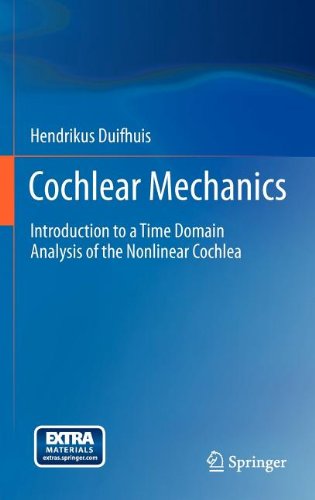Cochlear Mechanics: Introduction to a Time Domain Analysis of the Nonlinear Cochlea 2012
دانلود کتاب پزشکی مکانیک حلزون حلزون: مقدمه ای بر تحلیل حوزه زمانی حلزون غیرخطی
| نویسنده |
Hendrikus Duifhuis |
|---|
| تعداد صفحهها |
262 |
|---|---|
| نوع فایل |
|
| حجم |
2 Mb |
| سال انتشار |
2012 |
89,000 تومان
زمینه مکانیک حلزون در چند دهه گذشته توجه فزاینده ای را به خود جلب کرده است. در اکثر این مطالعات، محققان از تحلیل سیستم های خطی یا تقریب خطی برای سیستم های غیرخطی (NL) استفاده کرده اند. اگرچه واضح بود که حلزون دست نخورده به صورت غیرخطی عمل می کند، فقدان ابزار برای تجزیه و تحلیل غیرخطی مناسب و ابزارهای موجود برای تجزیه و تحلیل خطی هنوز به تفسیر ناکارآمد و احتمالاً نادرست بیوفیزیک حلزون منجر می شود. یک مثال از این فرضیه است که تغییر در سفتی حلزون (در سطح سلول مویی) باید تغییر مشاهده شده در تنظیم (یا تنظیم فرکانس) به دلیل (مثلا) کاربرد قبلی را توضیح دهد. تصورات نادرستی مانند اینها باید در یک برنامه آموزشی که به اندازه کافی روشن باشد تا تفاوت های اساسی بین حلزون های خطی و غیرخطی را در مقطع کارشناسی ارشد توضیح دهد، مورد توجه قرار گیرد.
این کتاب یک رویکرد منطقی/توجیه ریاضی مفید و مفید را در قسمت اصلی متن ارائه میکند، رویکردی که با مثالهای واضح نشان داده خواهد شد. این کتاب برای دانشمندان علوم اعصاب شنوایی و همچنین برای دانشجویان فارغ التحصیل رشته بیوفیزیک/مهندسی بیوپزشکی مفید خواهد بود.
The field of cochlear mechanics has received an increasing interest over the last few decades. In the majority of these studies the researchers use linear systems analysis or linear approximations of the nonlinear (NL) systems. Even though it has been clear that the intact cochlea operates nonlinearly, lack of tools for proper nonlinear analysis, and widely available tools for linear analysis still lead to inefficient and probably incorrect interpretation of the biophysics of the cochlea. An example is the presumption that a change in cochlear stiffness (at hair cell level) must account for the observed change in tuning (or frequency mapping) due (e.g.) prestin application. Misconceptions like this need to be addressed in a tutorial that is lucid enough to explain basic differences between linear and nonlinear cochleae at a graduate level.
This book presents a useful and mathematically justified/justifiable approach in the main part of the text, an approach that will be elucidated with clear examples. The book will be useful to scientists in auditory neuroscience, as well as graduate students in biophysics/biomedical engineering.




